The Pali Highway Resurfacing, Waokanaka St to Kamehameha Hwy project was completed in 2020. HAPI wrote an article about the project which was the cover story for the March 2020 issue of Roads & Bridges Magazine.
Below is the article as it appeared on the Roads & Bridges Magazine website (click here to view the article on their website).
This article was published as “Rolling with It” in March 2020 issue – magazine version. Click here for the digital version and click here for a PDF file.
A highway improvements project in Hawaii braved some major challenges
by Jon Young / March 02, 2020
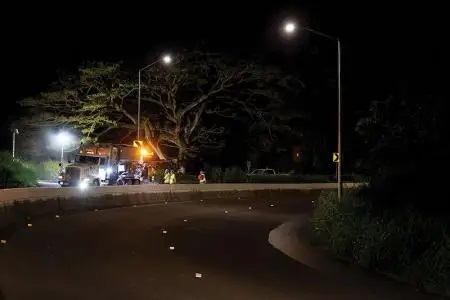
On Jan. 24, 2018, the Hawaii DOT’s (HDOT) Highways Division held a blessing ceremony for the Pali Highway Improvements Project. This project, which began in December 2017, replaced streetlights from Vineyard Boulevard to Kamehameha Highway and repaved Pali Highway from Waokanaka Street to Kamehameha Highway, including the parallel Waokanaka Street.
The project gave the roadway a much-needed face-lift, as well as other improvements. The scope of work included new lighting systems over the full 7.5 miles of roadway, asphalt pavement reconstruction and resurfacing for 5 miles from Waokanaka Street to Castle Junction, 4.3 miles of guardrail replacement, and 3.3 miles of concrete median barrier, along with other, smaller elements. And in addition to the planned scope of work, emergency work was added to the project after landslides impacted the project area.

DESIGNING RIGHT
Due to the narrow width of some areas of the median, the existing highway light poles were too close to the guardrail, so the guardrail may not have adequately protected errant vehicles from hitting a light pole. In those narrower areas, the guardrail was replaced with concrete median barrier, and the light poles were placed on top. HDOT has been moving away from the National Cooperative Highway Research Program (NCHRP) Report 350 crash testing procedures and towards using AASHTO’s Manual for Assessing Safety Hardware (MASH). As such, the jersey-shaped barriers used in the HDOT Standard Details are no longer valid. The project settled on a single slope concrete median barrier used by California DOT (Caltrans) that was MASH compliant.
Existing storm drain catch basins were located under the guardrails in the median. Since the guardrails were being replaced by concrete median barriers, the existing top slab would become exposed, creating a potential launching hazard for drivers. To eliminate this launching hazard, the top slabs and walls of 19 catch basins had to each be custom-designed and reconstructed.
There are 12 bridges on the Kailua side of the tunnels with integral light pole pedestals to support the light poles. The pedestals were not strong enough to meet the current code and had to be strengthened. The bridges, including the rails and pedestals, are considered “historic,” thus fiber-reinforced polymer (FRP) was used to strengthen the pedestals and maintain the look of the original bridge structure.
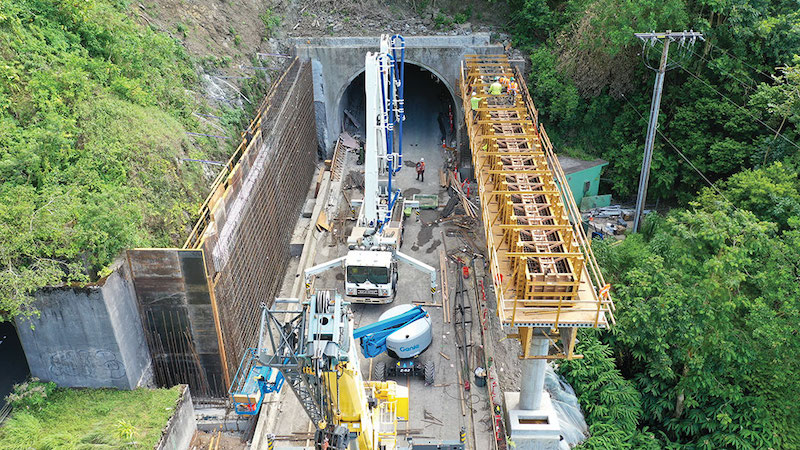
A SOLID PAVE
To provide a quality pavement, asphalt paving subcontractor Grace used the Trimble 3-D grade control system for the cold planing portions of the work to re-profile the road to achieve the design elevations.
During the pavement reconstruction and cold planing operations, unforeseen obstructions were encountered, such as buried concrete gutters and concrete pavement. To avoid cost and time impacts to remove these obstructions, modifications to the designs were needed. Paving fabrics were used over these structures to minimize pavement failures and reflective cracking.
HDOT has been looking for ways to extend the life of its pavements, recently deciding that stone matrix asphalt (SMA) would serve that purpose. HDOT used SMA for only two previous projects completed in 2004 and 2013, respectively. The pavement for both projects is still in good condition, and it is anticipated that the same result for the Pali Highway pavement will be realized, which used SMA for the surface course.
The paving improvements included over 24,000 cu yd of excavation of weakened pavement areas, 190,000 sq yd of cold planing, 27,000 tons of hot-mix asphalt base course, 40,000 tons of State Mix IV (similar to Superpave 12.5 mm), and 19,000 tons of SMA for the surface course. In addition, 7,000 sq yd of high-friction surface treatment was applied to the surface of the pavement at the hair pin curve on the Kailua side of the tunnels to provide better traction on the 10% superelevated section.
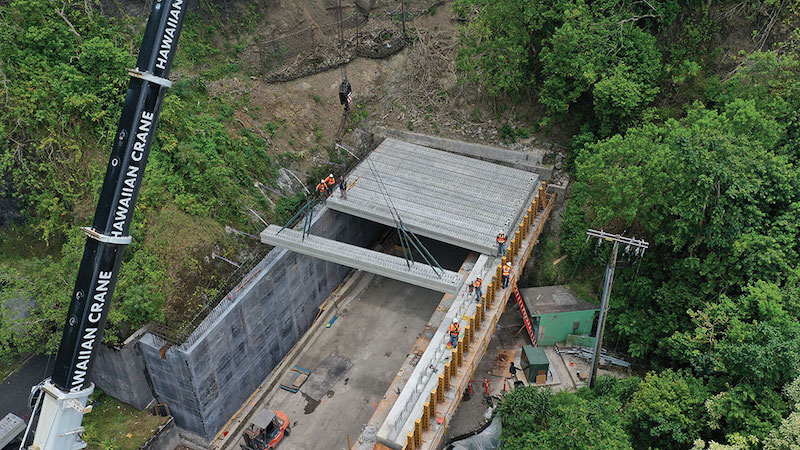
The use of SMA for the surface course was a change order to the scope of work. The production of the SMA versus hot-mix asphalt (HMA) was nearly the same; however, it did have some unique characteristics that slightly impacted the process. For example, the work window was slightly shorter, as the temperature of the mix needed to be closely monitored. Also, handwork areas with the material were not as forgiving as HMA Mix IV. Lastly, cutting into the SMA pavement was not recommended due to the gap-graded nature of the mix. With this restriction, all traffic and weigh-in-motion loop detectors were required to be installed within the pavement lift just beneath the SMA surface course, which impacted scheduling and coordination.
At the hairpin curve, the choice to employ high-friction surface treatment (HSFT) was rather novel for this region. While HFST is not a new product, it is something relatively new to highways in Hawaii. HFST utilizes a special calcined bauxite aggregate and a polymer resin binder to dramatically increase pavement friction in areas with known or potential traffic safety concerns. It has been recognized by the FHWA as a solution to reduce crashes and fatalities associated with friction demand issues such as a reduction in pavement friction, or high friction demand due to vehicle speed and/or roadway geometrics. Drivers have already reported they can feel the difference (improvement) as they travel this section of the road. The HFST was originally planned to be applied on State Mix IV; however, it was found in other states that shallow horizontal tearing presented after a couple of years. To minimize this concern, HDOT recommended a PG 76-22 polymer modified asphalt (PMA) binder in lieu of the specified neat PG 64-16 binder to produce the State Mix IV. PMA binder has been found to increase the shear strength in a pavement and minimize possible shallow horizontal tearing. Challenges for this change included coordination and reviews for mix designs and specifications.
Typical to all roadway construction, traffic control played a major role in all elements of the work. Despite being a major commuter highway, most of the roadway consists of two lanes in each direction and therefore limited construction closures to single-lane, daytime closures. To facilitate safety and production, construction was predominantly transitioned to night work where a full directional closure was allowed from the windward (Kailua) side to town. Given this closure, construction activities were given the opportunity to travel along the 5-mile section of road without the risks associated with live public traffic, despite the associated visibility challenges for workers which always accompany night work.
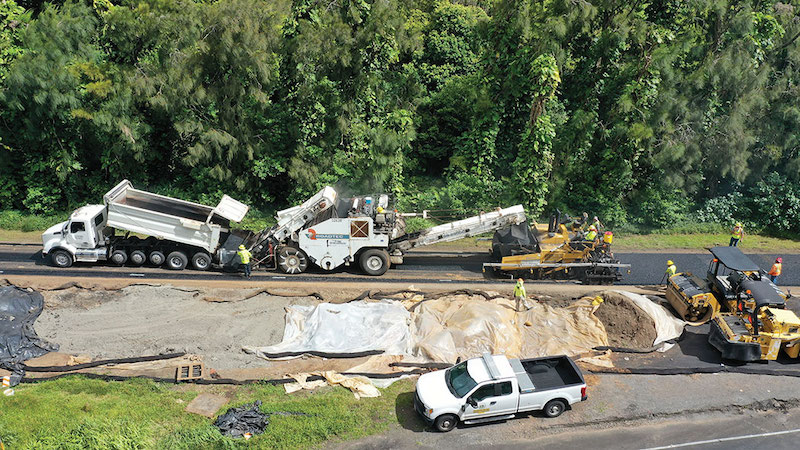
DISRUPTIONS
One persistent disruption was weather, which became a huge obstacle during the project schedule and production. Frequent rain events disrupted and canceled a significant portion of the paving operations. It also led to a stark development.
On Feb. 18, 2019, a massive landslide sent debris down onto Old Pali Road. This section of Old Pali Road is a remnant of the old roadway that has been out of service since Pali Highway was opened in 1959. The large volume of the landslide overwhelmed the upper road and sent the old concrete road, boulders, and debris crashing down on the town-bound lanes of Pali Highway.
To make matters worse, a second landslide just above the highway sent large volumes of dirt onto the Kailua-bound lanes at the same time. The highway was immediately shut down for safety. Prometheus Construction, a rockfall mitigation contractor, came on site to both assess the landslide and clear the slopes of immediate hazards.
After a few design iterations, HDOT settled on a two-part system to protect the public from potential landslides happening hundreds of feet above the town-bound lanes of Pali Highway. The first part was based on an attenuator system to catch and dissipate the momentum of falling debris. The second part was an 80-ft-long rock shed structure extending the existing town-bound tunnel. The design added 8 ft of high-density foam to protect the structure from any potential impacts. The town-bound Pali Highway remained fully closed, while the Kailua-bound lanes were contra-flowed for construction to address the landslide.
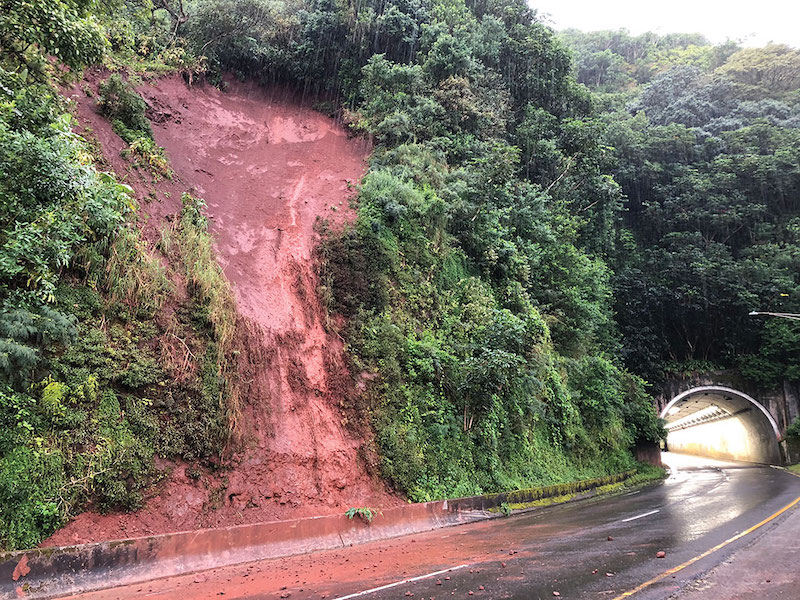
Even though repairs due to damage from the landslides were classified as an emergency job, the design and start of construction for those repairs had to clear environmental and historic regulations. Given the historic nature of the Pali tunnels, design was required to preserve certain aspects of the original aesthetics. The face of the structure was designed to have precast slabs built to imitate the adjacent existing portal face. Special concrete coloring was required and sampled to match the weathered concrete look of the existing concrete surfaces.
The final structural design required an 80-ft-long x 40-ft-wide structure using a precast concrete plank system spanning from a retaining wall along the existing mountain and a drilled shaft/column support on the cliff side. Additional lateral support for the structure included rock anchors drilled into the mountain while avoiding the parallel Kailua-bound tunnel. Atop the structure, a two-tiered wall system containing energy-absorbing geofoam topped with shotcrete was set.
Both the landslide mitigation and the resurfacing/lighting projects were substantially completed in early February of this year. As the rock shed and slope stabilization progresses, access to the roadway is being given back to the public on a phased schedule.
And when all is said and done, the completed project will provide a safer, newer, and smoother-riding, long-lasting road for the commuting public.
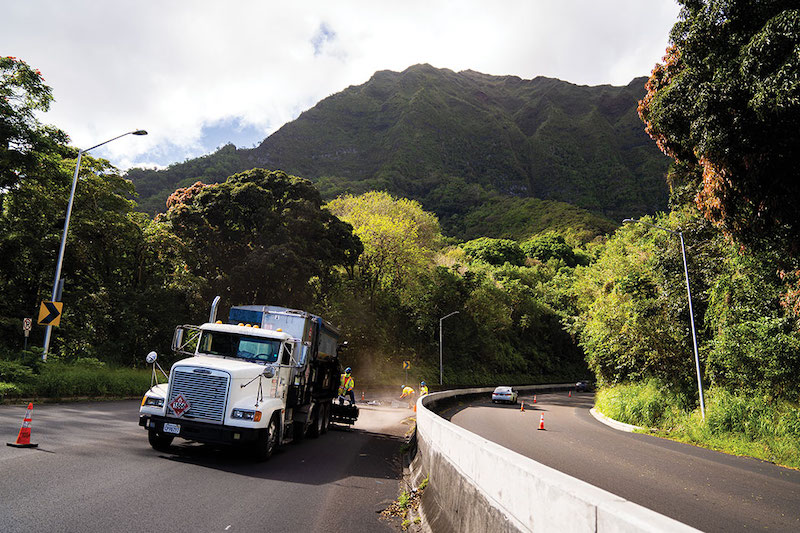
Image courtesy of Lucas Carter / IEA.
About the Author:
Young is Executive Director of the Hawaii Asphalt Paving Industry.

